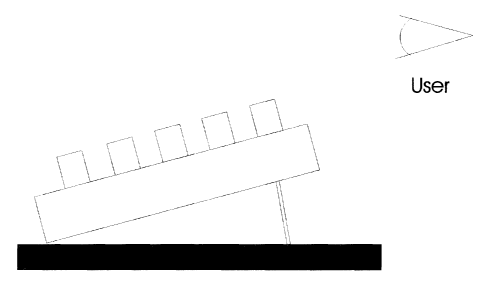Note: Descriptions are shown in the official language in which they were submitted.
CA 02448420 2005-08-29
ERGONOMIC KEYBOARD TILTED FORWARD WITH NON-QWERTY KEY LAYOUT
The invention relates to ergonomic keyboards for computers and terminals.
In an effort to minimize repetitive strain injuries ( RSI ) such as carpal
tunnel syndrome,
keyboard manufacturers have turned their attention to ergonomic keyboards.
Several approaches
have been used.
One approach involves arranging the keys along a flat V or U shape instead of
a straight
horizontal line. The keys are arranged either in one continuous group along
this shape, or in two
groups. The advantage is that the angle of the user's arms is more natural and
therefore more
relaxed. Sometimes the keyboard also has a wrist rest. For example, see
Camacho ( US patent
6,467,979 and others ).
Another approach involves the use of the Dvorak key layout ( ANSI standard
X3.207 ) instead of
the more common QWERTY key layout. The advantage is that the most commonly
used keys are
located on the home row, which minimizes forger travel and extension. For
example, see
Zagnoev ( US patent 5,936,555 ).
Another approach involves placing the keys below the level of the user's palm,
or tilted
downwards away from the user. This is instead of the usual arrangement where
the keyboard is
either tilted upwards away from the user, or it is flat on the desk. The
advantage is that the user's
palm slopes downwards along the surface of the keys, so it continues along the
line formed by
1
CA 02448420 2003-11-07
the user's arm from the shoulder downwards. Therefore the user's palm is more
relaxed. For
example, see Hargreaves ( US patent 6,005,496 and others ).
All these approaches are beneficial. Some of the prior art combines a number
of approaches to
improve the keyboard. It would be best to combine all of these approaches.
SUMMARY
This invention combines the three approaches described in the prior art
section to create an
ergonomic keyboard. The keyboard has a Dvorak key layout. It is tilted
downwards away from
the user. The keys are arranged in a V or U shape. It has a wrist rest. The
result is a superior
ergonomic keyboard that helps minimize repetitive strain injuries.
DRAWING FIGURES
Fig. 1: The keyboard with the character keys arranged in 2 groups in a V
shape.
Fig. 2: Side view of the keyboard without a wrist rest.
Fig. 3: Side view of the keyboard with a wrist rest.
Fig. 4: Side view of the keyboard with a different kind of wrist rest.
Fig. 5: Side view of the keyboard with a concave profile and with a wrist
rest.
2
CA 02448420 2003-11-07
DETAILED DESCRIPTION
This keyboard combines a number of ergonomic features.
The keyboard uses the Dvorak key layout instead of the usual QWERTY. The keys
are arranged
in a V or U shape. Fig. 1 shows the character keys arranged in two groups to
form a V shape. The
keys can also be arranged in one group and in a U shape.
The Dvorak key layout can be split in two groups using the groups as shown in
fig. 1, or split in
two different groups. Only character keys are shown. Other keys such as
numeric, punctuation,
arrow and function keys are not shown. Placement of these keys will vary in
different
implementations. The implementations do not necessarily adhere to ANSI
standard X3.207.
The preferred embodiment of the keyboard has character keys in the layout
shown in fig. 1. Fig. 1
shows the keys arranged in straight rows and columns. This is not necessarily
the case. In most
implementations the columns will not be vertical as shown. For example, S will
not generally be
straight above Z, and E will not be exactly above J.
The keyboard is tilted downward away from the user. See fig. 2. This is
different from the usual
keyboard which is either flat on the desk, or is tilted upward away from the
user.
The keyboard has a wrist rest. Fig. 3 and fig. 4 show two different wrist
rests. Other positions for
the wrist rest are also possible. For example, a horizontal wrist rest such as
the one in fig. 4 can
3
CA 02448420 2003-11-07
be used, but it can be located higher, at a longer distance from the keys. The
preferred
embodiment has a horizontal wrist rest generally as shown in fig. 4, but it
can be located higher,
at a longer distance from the keys.
The keyboard can be curved: concave or convex. Fig. 5 is a concave keyboard
with a wrist rest.
The keyboard has a switch that changes the key configuration from Dvorak to
QWERTY.
The foregoing description of the preferred embodiment of the invention and
some possible
variations has been presented for the purposes of illustration and
description. It is not intended to
be exhaustive or to limit the invention to the precise form disclosed. Many
modifications and
variations are possible. It is intended that the scope of the invention be
limited not by this
detailed description, but rather by the claims appended hereto.
4
